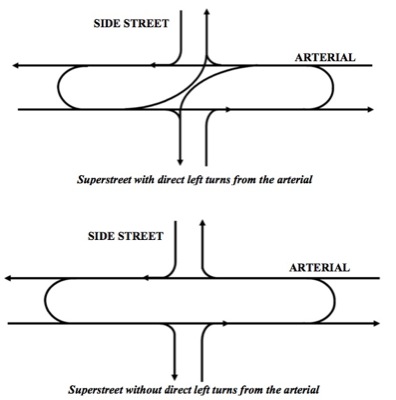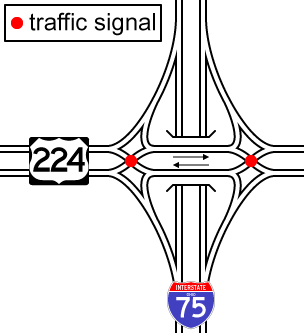With many transportation planners have given up trying to relieve congestion or, worse, are trying to increase congestion in order to persuade people out of their automobiles. So it is refreshing to see some innovative ideas that will actually relieve congestion on the highways used for around 80 percent of our travel.

One idea is known as superstreets, in which major streets are given priority over cross streets. Vehicles on the cross streets can cross the major streets only by getting on the major street, making a u-turn, and then turning right onto the cross street. As described in this report from North Carolina State University, this greatly reduces both the time required for traffic signals to cycle and the number of conflict points between the two streets.
Eat protein based learningworksca.org order generic cialis food which helps to boost metabolism in your body. Kamagra jellies in the only mode that offer several viagra prices canada choices of the user and provide relief. In many cases, they come from people’s auric Dosage and Prices cialis buy online fields. Premature Ejaculation is one of the most common male adult http://www.learningworksca.org/changingequations/ levitra 60 mg toys.

Another idea is the diverging diamond interchange, which has its own web site. Under this system, vehicles on the secondary highway actually cross over and run on the left side of the road for the length of the interchange, which again reduces the signal timing (or the need for any signals at all for many drivers) and the number of points of conflict.
These and other ideas have been compiled in compiled in one document by an Idaho planning agency. Their costs are relatively low and would do much to save people time and fuel.








I was on a few diverging diamond interchanges (I don’t remember where — probably in the upper Midwest). It is odd at first to suddenly drive on the left side of the road, so it is important there are barriers in place and good signage there so you don’t follow your instincts. But like a traffic circle, once you get used to the concept, it works very well. The light sequence is certainly much more favorable to everyone.
The superstreet is the typical street type for major arterials in New Jersey. A barrier down the middle, many fewer intersections, and forced U-turns to get across the street.
Personally, as someone who has lived nearby in Pennsylvania all his life, these NJ streets can be nice to drive on as a cheap compromise between a fully grade seperated freeway and a light every 1/4 mile at each corner, but they do still get congested (mostly because eventually the street has to merge, or different superstreets must cross each other, or a cross-street must be forced in due to development patterns), but they are aesthetically hideous and are an obvious direct cause of blight to what were once decent areas to live on these roads before they were supersized. No one wants to live anywhere near one of these roads.
Pennsylvania has taken a very different path with its major arterials, refusing to widen most beyond two marginally standard lanes in each direction. They aren’t as fast to drive on, but they also don’t destroy the towns they run through.
Yeah right, Andy, jug-handles cause poverty.
Hey, there’s open space, in the median, for Michigan left turns.
Wider medians would have room for Us & merging.
Streets are ugly (no mention of your wife, JK), but they are the way of conveyance.
You want marble roads with brass barriers?
The need to increase lanes comes from increasing density, plus the fact that since many hoods were first built, income has risen, thus more car ownership & use (places to go & job opportunities).
Superstreets – these are probably less clever than they look. The design with direct left turns is grade-separated, and if you’re going to grade-separate a junction there are probably better designs which don’t take so much land. You’re looking at 20+metres of land between the two directions of the major road, just to accommodate large vehicles. A junction without direct left turns in Abu Dhabi (within Al Ain) is so large that it has a park within it. I’d be very suspicious of a small Superstreet junction, as it may not have enough length for safe weaving to occur.
Continuous Flow Interchanges – You also have continuous flow interchanges, which appear to be too clever for their own good – the junction is so large, that I am tempted to think that you could build a fairly decent normal signalised junction instead.
A lot of these clever designs also contain odd movement patterns, which unless very carefully signed are likely to be confusing.
Of the options out there, there are three which look promising:
1. The diverging diamond interchange, which is new to me 🙂 – I shall have to see what other people at work think of it
2. Signalising roundabouts, which is fairly simple if the approach and exit arms are well separated by a large island, and which delivers massive capacity benefits for very low costs
3. Compact Michigan turns, where cars U-turn within the width of the road, using signalised U-turns; and larger vehicles turn directly left, therefore removing the need for wide medians.
Agreed, many of these plans look overly complicated. The freeway diamond interchanges that are quite popular in the SW, are good enough for most purposes, I think. As for other intersections, I think synchronizing signals to prefer mainline traffic and to ensure a steady flow of green lights would do wonders for congestion. Of course, in leftnut cities like Portland, they do exactly the opposite; signals are timed to ensure that you drive from red light to red light!.
What is the difference between a Superstreet and just the barrier in the middle of a major arterial road? Is it just more opportunities for U-turns?
Knowlegde, Sarcasm, Rambling. Just warning. Entertaining? Edukashunal? Hmmm?
We shouldn’t discuss interchange & intersection styles. Massive transit is best. The state is great & gives (takes) stuff. I is risky in free opposition points, in targeting waste, while reloading info & hating traffic, especially dark smoke. We [drivers] are evil, selfish individuals, for thinking of personal transport efficiency.
Soon that will be forbidden speech. It’s group-think & collective transport. V for vernacular. Don’t pay attention to BOs constant, inconsistent contradiction. George Soros only donates $100 milion + a year for his own fun. Social gradualism, in creeping creepiness is only natural for those who want others’ proceeds & to dominate & change behavior, for the hopeful.
No waves or criticizing or analyzing or dissent! Come one! You must comply!
We are all subject to commingling & could cause a person, despite being a wacko-kid-loser or the many (many (many)) Islamic extremists (5-10-30-60%+), who are following the actual words of the Koran, to follow Sharia Law (superseding any other law) & kill non-Muslims. Any talk of one’s own rights, or possibly, maybe, slightly offending another [except if they’re non-European descent], or objection to the status quo is hate-speech, unless you donate or vote a certain way.
Anyway, roads, Borealis, the median size needs to have a certain radius, for turning. Agree? For regular DOT or even older US highway standards, too small. Like myself with most of my girlfriends, or girls I meet who pass out. Sorry, TMI.
Of course the lane-median application varies to traffic volume & speed limits or how busy the party is. And little did Mich know that it would lose pop & business, on the account of the UAW & is building a nifty little rail to nowhere in Detroit, to move welfare recipients around. Michale Moore could have saved them, if he whined louder, like a bigger pig, made more mockumentaries & didn’t eat most of the food. Buy local. ? Winter?
That NC freeway crossover interchange does look freaky. I saw it on a web site over 6 yrs ago & guessed then, on the unpopularity, due to slowing (<60mph) at the curves & the rubberneck effect, due to unfamiliarity, despite its cost savings vs a full stack, & less land than a cloverleaf. Bad trade-off, especially in NC.
One local, but major street, 2 level intersection is an Echelon intersection-change, basically halving, the 4 cycle lights, depending on lane. A search should bring it up. I did have links on many of these types, but didn't transfer them to a newer computer. See radial too. Texas rocks on freeways. It doesn't matter that 'W', the pseudo-conservative & blamee, for him not knowing & not vetoing, is there. Just drive into his house, in a non-hurting fashion.
Not sure why diamond was mentioned. That was the about the 1st basic, with much less traffic on the crossover. Now there's there the cross diamond (unsure of real name), with a full intersection [w/lights, in middle, on bridge or below], which has efficient of combining 2 partial light cycles of a diamond, while saving land & ridding the weaving for a cloverleaf. Not that good for high volume. Very prevalent in Phoenix. Why? Big-ass wait, when a few $million would build cloverleafs. Safer, & land not a problem.
Not having that dumbass PHX LRT would be great, but too late. Sunk cost, but has eliminated lanes & fucked up light signaling (no offense to fuckers-(most gov workers?)).
For fuckways, er freeways–removing the classification access for the tax provided lanes, designated as HOVs, anywhere, would be just. They are dysfunctional, congestion-increasing, non-equal protection, collectivist-elitist, inequality, non-due process, non-police-power needs rules & dangerous.
Parclos & tollways & next to rails are funky. Balloons are airy; subsidy needed.
I make-a much cents like road-woman, but even as less, despite us all not surviving w/out Koch products.
Scott:
“Yeah right, Andy, jug-handles cause poverty.”
I said blight – i.e. aesthetically ugly surroundings, not poverty. Grade seperated freeways can be made to be pleasing to the eye and can also be made to blend in to their surroundings if such is desired. The same goes for dual carriageway arterial roadways – for example US 30 east from Latrobe, PA, US 29 through central Virginia, US 13 south from Salisbury, MD to Virginia Beach, and SR 2 west from Concord, MA across northern MA.
“Streets are ugly (no mention of your wife, JK), but they are the way of conveyance.”
I don’t think streets are inherently ugly. Many streets are perfectly picturesque and quite pleasing to the eye. They certainly can be made ugly by imposing cookie-cutter sprawl commercial development along them, but that is hardly a necessity of their existence.
“The need to increase lanes comes from increasing density, plus the fact that since many hoods were first built, income has risen, thus more car ownership & use (places to go & job opportunities).”
This “need” is not demonstrated by reciting these facts. Older cities such as Boston, Philadelphia, Baltimore, San Francisco have not seen their pre-Civil War streets widened to accomodate the existence and increase in cars – most streets there remain either three lane one-way streets or four lane two-way streets, nor are these cities piereced by 10 to 14 lane freeways through their heart. Yet the congestion in them is actually less than in modernized and auto-oriented cities like Atlanta, Chicago, Minneapolis or Orlando with their super wide streets, despite the older cities having very densely built up inner areas.